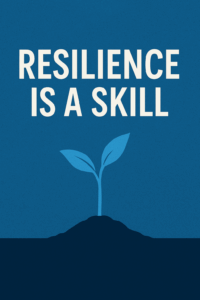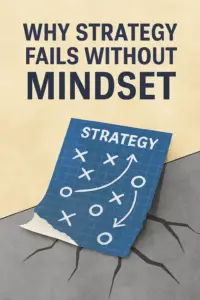The Brain as Your Most Valuable Asset
Entrepreneurs often obsess over capital, technology, or market timing. But the real engine of growth is the brain itself. Neuroplasticity in entrepreneurship, the brain’s ability to rewire and form new connections, is what allows us to adapt, innovate, and recover from setbacks.
When you understand how to train your brain, you stop relying on luck or perfect timing. You start building adaptability, creativity, and resilience into your operating system.
Why Neuroplasticity Matters in Business
- Adaptability
Markets shift, competitors emerge, and technologies evolve. A brain wired for flexibility through neuroplasticity in entrepreneurship can pivot faster and spot opportunities others miss. - Creativity
New neural pathways fuel fresh ideas and unconventional solutions. Innovation isn’t just a spark; it’s the result of a brain trained to connect dots in new ways. - Resilience
Reframing failure as feedback strengthens both mindset and strategy. https://michaelairo.com/resilience-is-a-skill/ Resilience is a skill that can be trained, and neuroplasticity is the mechanism that makes it possible. Neuroplasticity in business means you don’t just bounce back; you bounce forward.
Practical Habits to Train Neuroplasticity
- Micro‑Learning
Consume small, diverse inputs daily such as articles, podcasts, and conversations. This keeps your brain exposed to novelty, sparking new connections and strengthening neuroplasticity in business. For example, reading a short article outside your industry can spark an idea that applies directly to your market. - Deliberate Practice
Break complex skills into smaller drills. Just like athletes, entrepreneurs grow stronger through repetition and refinement. When I was building new teaching frameworks, I didn’t try to overhaul everything at once. I practiced one small shift at a time until it became second nature. - Mind‑Body Integration
Exercise, meditation, and sleep aren’t luxuries. They are the fuel for neural rewiring. Physical wellness directly supports cognitive flexibility. A brisk walk before a strategy session often unlocks more creative solutions than another hour at the desk. - Reframing Challenges
Instead of “I failed,” try “I learned.” This subtle shift rewires the brain to seek growth instead of avoiding risk. And when you catch yourself saying “I can’t,” add the phrase not yet. That small shift rewires the brain to expect progress instead of permanence.
And when you catch yourself saying “I can’t,” add the word not yet. That small shift rewires the brain to expect progress instead of permanence.
Case Example 1: Celebrating Mistakes as Learning Reps
In my own leadership, I’ve made it a practice to treat every mistake as a moment to celebrate. Instead of punishing errors, I reframe them as proof that we’ve just discovered one more way it doesn’t work. That shift turns failure into feedback, exactly how neuroplasticity in entrepreneurship operates.
I carried this same approach into the classroom. Whenever a student stumbled, we paused to highlight the attempt, not the error. By normalizing mistakes as opportunities to grow, the group began to take more risks, share bolder ideas, and recover faster from setbacks.
One student once told me, “I used to freeze when I got something wrong. Now I see it as a rep for my brain.” That shift didn’t just improve performance in class — it built confidence that carried into their career.
Later, I saw the same principle play out in a startup team. They began holding “failure roundtables” where each member shared a recent misstep and what they learned. Instead of shame, these sessions built camaraderie and accelerated innovation. Within months, their product roadmap was stronger because they had normalized fast learning.
Over time, this culture of “celebrating mistakes” rewired both brains and behaviors. Teams learned to see each misstep as a neural rep, a chance to strengthen adaptability, creativity, and resilience. That’s the essence of neuroplasticity in business: not avoiding failure, but using it as raw material for growth.
Case Example 2: Laugh Breaks, Movement, and the Human Knot
In another classroom setting, I experimented with what I called “laugh breaks.” After students had been sitting too long and their focus started to fade, I paused the lesson for a quick burst of humor or a playful challenge. Sometimes it was as simple as a silly story, but often it involved short games that got them moving.
One favorite was the human knot: students stood in a circle, reached across to grab random hands, and then worked together to untangle themselves without letting go. It was chaotic, funny, and surprisingly effective. Within minutes, the room was buzzing with laughter, collaboration, and renewed energy. The exercise was not just a break. It was a live demonstration of problem‑solving, communication, and persistence.
That same principle applies in business. Teams stuck in long meetings or grinding through complex projects often lose focus, not because they lack skill, but because their brains need novelty and movement. A quick reset — whether it is a laugh break, a short energizer game, or even a standing brainstorm — can rewire the atmosphere. The result is sharper thinking, stronger collaboration, and more creative solutions.
I carried this into fitness as well. On Fridays, I ran “Casual Friday Workouts” as a break from the normal routine. Instead of standard lifts, we flipped tires, swung kettlebells, or even took sledgehammers to tractor tires. The novelty and fun re‑energized people who might otherwise have dragged themselves into the weekend. What looked like play was actually neuroplasticity in action: breaking patterns, engaging new neural pathways, and making the hard work feel fresh again.
The Four Habits of a Rewired Entrepreneur
To recap, here are the four cornerstone habits that train neuroplasticity:
- Expose your brain to novelty (micro‑learning).
- Break skills into drills (deliberate practice).
- Fuel the brain through the body (mind‑body integration).
- Reframe setbacks as reps (challenge reframing).
These habits compound. Practiced consistently, they don’t just change how you think — they change the structure of your brain itself. Try applying one habit this week. Read something outside your field. Break a big skill into a 10‑minute drill. Take a walk before your next strategy session. Or catch yourself saying “not yet” instead of “I can’t.” Small reps compound into rewiring.
Bringing It Together
Entrepreneurship is less about having the perfect plan and more about cultivating a brain that thrives in uncertainty. By training neuroplasticity in entrepreneurship through micro‑learning, deliberate practice, and reframing, you don’t just survive the entrepreneurial journey; you evolve with it.
Explore more in the Insights section, where neuroscience, resilience, and strategy intersect to fuel sustainable growth.



